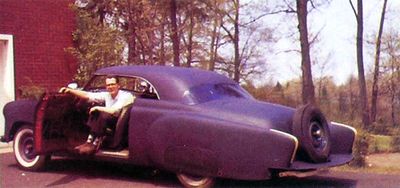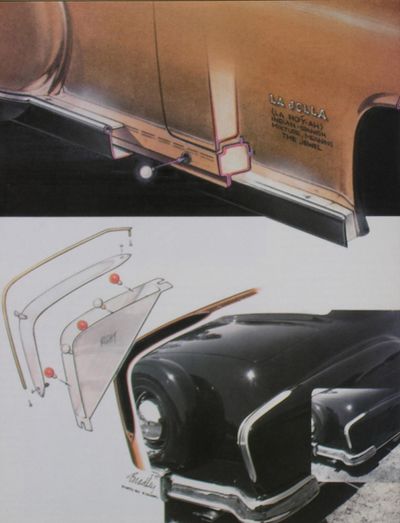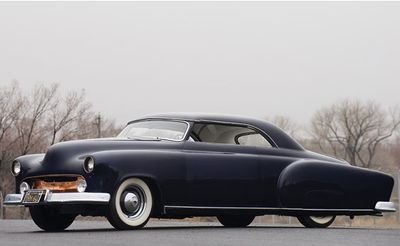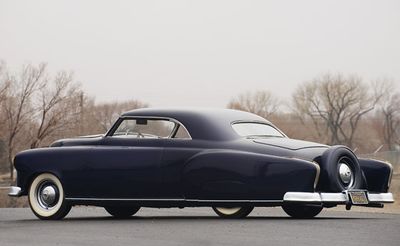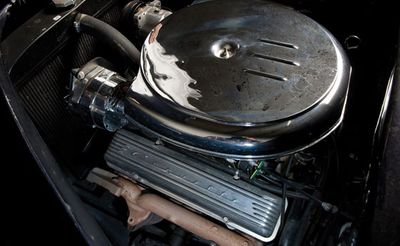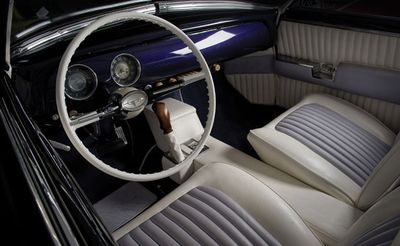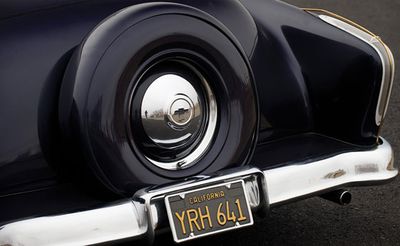Harry Bradley's 1951 Chevrolet Bel Air - La Jolla



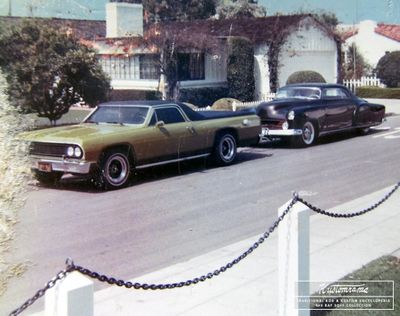

1951 Chevrolet Bel Air restyled by Harry Bradley. The car is also known as the La Jolla. Harry got into the early fifties Chevys after borrowing an all-black 1950 Chevrolet Bel Air from the guy who was dating his sister. He started to make sketches and designs, making plans for his own car. After a couple of years he wrangled a cherry red 1951 Chevrolet Bel Air from his parents. That was in 1954. The Chevy had been the milkman's car. When he got it, Harry promised his parents that he wouldn't touch the car, never. But it was too late; his parents didn't have a chance against the inspiration Harry had gotten from people like PininFarina, Harley Earl, Joe Bailon and the Barris Brothers. Harry picked the Chevy because it was a small car and because it had a sensitive design with an innovative roof and window treatment, something lacking in Fords. He also felt that the 1949-51 Fords lacked character.
The day he got the car he started to dechrome the hood and turned the gas filler neck into the trunk. From the beginning Harry wanted to simplify and make things flow together; he didn't want fussy details popping out. Harry wanted the car to be a good driver, so he rejected the idea of lowering it by heating the springs and using huge lowering blocks. So he channeled the body in order to give it the right ride height. The Chevy was channeled from the rear seat aft. This means that the frame and the floor were stepped just ahead of the rear springs. Legroom and comfort were then maintained in the passenger area.
The top was chopped about 3 inches. A lot of work went into the new lower side window area. Harry wanted the opening to be absolutely clear of any fixed glass, so he removed the vent windows. One-piece door glass was fabricated. The A-pillars were reworked to eliminate an offset at their base. Hand made lower windshield moldings were cast from lead and chrome plated to give the windshield a consistent appearance at all corners. A narrowed and sectioned 1949 Plymouth rear-window opening was installed in the roof. A 1953 Pontiac windshield was cut to fit. The rear window modifications were hammerwelded by Herb Gary. The taillight lenses were clear with a blush of pearl paint on the inner surface for light diffusion. Red lenses were rejected because they clashed with the brown body, a deep chocolate-ebony candy pearl. Red and clear bulbs were used for various lighting functions.
The pancaked hood and deck was a result of Harry's desire to make the wonderful contours between the body hull and the flanking fenders "read" without any interruption. The stock hood was molded in and a smaller panel was cut from the flatter top portion. The new hood was completely hand-formed by Herb Gary. The outer skin was flanged over an inner steel panel, with the edges rolled over a tube frame. The hood was electrically operated, using two screwdrives to raise and lower it. The doors were also operated electronically by solenoids, as the door handles were shaved for a cleaner look. The deck lid treatment was done after Harry was inspired by the first Lincoln Continental he ever saw. The trunk was also pancaked. The stock rear bumper was replaced by a 1953 Pontiac bumper incorporating 1949 Chevrolet license plate guards.
The floating rocker panel is a unique feature on the car. harry floated a false rocker away from the main body about 1 1/2 inches. This made the rocker fit snugly against the rear fender sheet metal. The new panel was trimmed with chrome tubing, the gap was bridged with frosted white plexiglass, one 1 1/2 inch by 36 inch piece on each side. At night the lens glows softly to bathe the lower body of the car in light. Directional signals were augmented by small lights at the leading edge of the panels.
Up front Harry frenched the headlights, and installed a 1949 Mercury grille opening. A new grille was then fabricated out of copper. Harry also smoothed the bumper, removed the bumper guards, and added a 1949 Chevrolet license plate guard.
The pictures on the right taken in 1956 show the La Jolla with dual spotlight mounted on the A-pillar. The spots were stolen early in the car's construction. Harry thought their absence looked more attractive, so he never replaced them. The car could be operated by a hand control which featured an accelerator, brake, dimmer switch, and cruise control. The hand controls were made by Harrys friend Floyd Martin.
The stock inline six engine was swapped for a 283 CID Chevrolet V-8.
In 1999 Harry sold the La Jolla to custom car collector Jack Walker. Until then the car had been registered every year since Harry got it. Jack worked with Harry to restore the car, adding to changes approved by Harry. Inside Jack had Harry design a new rolled and pleated interior in white and lavender. The upholstery was done by Bob Sipes. The second change was done to the car's paint, as Jack painted it in a dark purple.
September 26, 2009 the La Jolla was offered for sale at an RM Auction at the Petersen Automotive Museum where it is a part of the Icons of Speed & Style auction. The car sold for $ 24,750 USD.
Magazine Appearances
Sources
Did you enjoy this article?
Kustomrama is an encyclopedia dedicated to preserve, share and protect traditional hot rod and custom car history from all over the world.
- Help us keep history alive. For as little as 2.99 USD a month you can become a monthly supporter. Click here to learn more.
- Subscribe to our free newsletter and receive regular updates and stories from Kustomrama.
- Do you know someone who would enjoy this article? Click here to forward it.
Can you help us make this article better?
Please get in touch with us at mail@kustomrama.com if you have additional information or photos to share about Harry Bradley's 1951 Chevrolet Bel Air - La Jolla.
This article was made possible by:
SunTec Auto Glass - Auto Glass Services on Vintage and Classic Cars
Finding a replacement windshield, back or side glass can be a difficult task when restoring your vintage or custom classic car. It doesn't have to be though now with auto glass specialist companies like www.suntecautoglass.com. They can source OEM or OEM-equivalent glass for older makes/models; which will ensure a proper fit every time. Check them out for more details!
Do you want to see your company here? Click here for more info about how you can advertise your business on Kustomrama.
